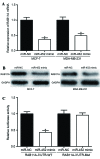Tumor-suppressive microRNA-452 inhibits migration and invasion of breast cancer cells by directly targeting RAB11A
- PMID: 28781694
- PMCID: PMC5530176
- DOI: 10.3892/ol.2017.6426
Tumor-suppressive microRNA-452 inhibits migration and invasion of breast cancer cells by directly targeting RAB11A
Abstract
Breast cancer is the most common type of malignant tumor in females, and metastasis is the most common cause of breast cancer-associated mortality. Previous studies have identified that abnormal expression of microRNAs is commonly observed in human cancer and may be crucial for cancer metastasis. In the present study, microRNA-452 (miR-452) was investigated for its ability to act as a tumor suppressor in breast cancer. miR-452 expression was quantified in breast cancer tissue samples and cell lines with reverse transcription-quantitative polymerase chain reaction (RT-qPCR). Transwell migration and invasion assays were used to investigate the effect of miR-452 on the migration and invasion capabilities of breast cancer cells. Potential target genes of miR-452 were identified with miRanda and TargetScan. A luciferase reporter assay was performed to validate RAB11A as a putative target of miR-452, and was corroborated by RT-qPCR and western blot analyses. Finally, small interfering RNA (siRNA) was used to knockdown RAB11A expression and confirm whether miR-452 inhibited breast cancer cell migration and invasion via the negative regulation of RAB11A. The results revealed that miR-452 was downregulated in breast cancer tissues and cell lines, and that its downregulation may be associated with breast cancer metastasis, as miR-452 expression inhibited the migration and invasion capacities of breast cancer cells. RT-qPCR and western blot analyses indicated that miR-452 negatively regulated the expression of RAB11A mRNA and protein. The luciferase reporter assay revealed that miR-452 specifically bound to the 3'-untranslated region of RAB11A. Furthermore, inhibition of RAB11A with siRNA inhibited breast cancer cell migration and invasion. In conclusion, the present study has demonstrated that miR-452 may act as a tumor suppressor gene via inhibition of cell migration and invasion by targeting RAB11A in breast cancer.
Keywords: RAB11A; breast cancer; metastasis; microRNA-452.
Figures






Similar articles
-
MicroRNA-335 is downregulated in papillary thyroid cancer and suppresses cancer cell growth, migration and invasion by directly targeting ZEB2.Oncol Lett. 2017 Dec;14(6):7622-7628. doi: 10.3892/ol.2017.7126. Epub 2017 Oct 3. Oncol Lett. 2017. PMID: 29344210 Free PMC article.
-
MicroRNA-320a inhibits proliferation and invasion of breast cancer cells by targeting RAB11A.Am J Cancer Res. 2015 Aug 15;5(9):2719-29. eCollection 2015. Am J Cancer Res. 2015. PMID: 26609479 Free PMC article.
-
MicroRNA-421 inhibits breast cancer metastasis by targeting metastasis associated 1.Biomed Pharmacother. 2016 Oct;83:1398-1406. doi: 10.1016/j.biopha.2016.08.058. Epub 2016 Aug 29. Biomed Pharmacother. 2016. PMID: 27583980
-
miR-96 promotes tumor proliferation and invasion by targeting RECK in breast cancer.Oncol Rep. 2014 Mar;31(3):1357-63. doi: 10.3892/or.2013.2934. Epub 2013 Dec 19. Oncol Rep. 2014. PMID: 24366472
-
Multiple functions and dual characteristics of RAB11A in cancers.Biochim Biophys Acta Rev Cancer. 2023 Nov;1878(6):188966. doi: 10.1016/j.bbcan.2023.188966. Epub 2023 Aug 30. Biochim Biophys Acta Rev Cancer. 2023. PMID: 37657681 Review.
Cited by
-
Genetic variations in tumor-suppressor miRNA-encoding genes and their target genes: focus on breast cancer development and possible therapeutic strategies.Clin Transl Oncol. 2024 Jan;26(1):1-15. doi: 10.1007/s12094-023-03176-8. Epub 2023 Apr 24. Clin Transl Oncol. 2024. PMID: 37093457 Review.
-
MicroRNA-452: a double-edged sword in multiple human cancers.Clin Transl Oncol. 2023 May;25(5):1189-1206. doi: 10.1007/s12094-022-03041-0. Epub 2023 Jan 9. Clin Transl Oncol. 2023. PMID: 36622551 Review.
-
MicroRNA 452 regulates IL20RA-mediated JAK1/STAT3 pathway in inflammatory colitis and colorectal cancer.Inflamm Res. 2021 Aug;70(8):903-914. doi: 10.1007/s00011-021-01486-7. Epub 2021 Jul 20. Inflamm Res. 2021. PMID: 34283251
-
Extracellular vesicles derived from Wharton's Jelly mesenchymal stem cells inhibit the tumor environment via the miR-125b/HIF1α signaling pathway.Sci Rep. 2022 Aug 8;12(1):13550. doi: 10.1038/s41598-022-17767-y. Sci Rep. 2022. PMID: 35941273 Free PMC article.
-
Identification and differential expression of microRNAs in Madin-Darby canine kidney cells with high and low tumorigenicities.Genes Genomics. 2022 Feb;44(2):187-196. doi: 10.1007/s13258-021-01177-x. Epub 2022 Jan 20. Genes Genomics. 2022. PMID: 35048333
References
LinkOut - more resources
Full Text Sources
Other Literature Sources
